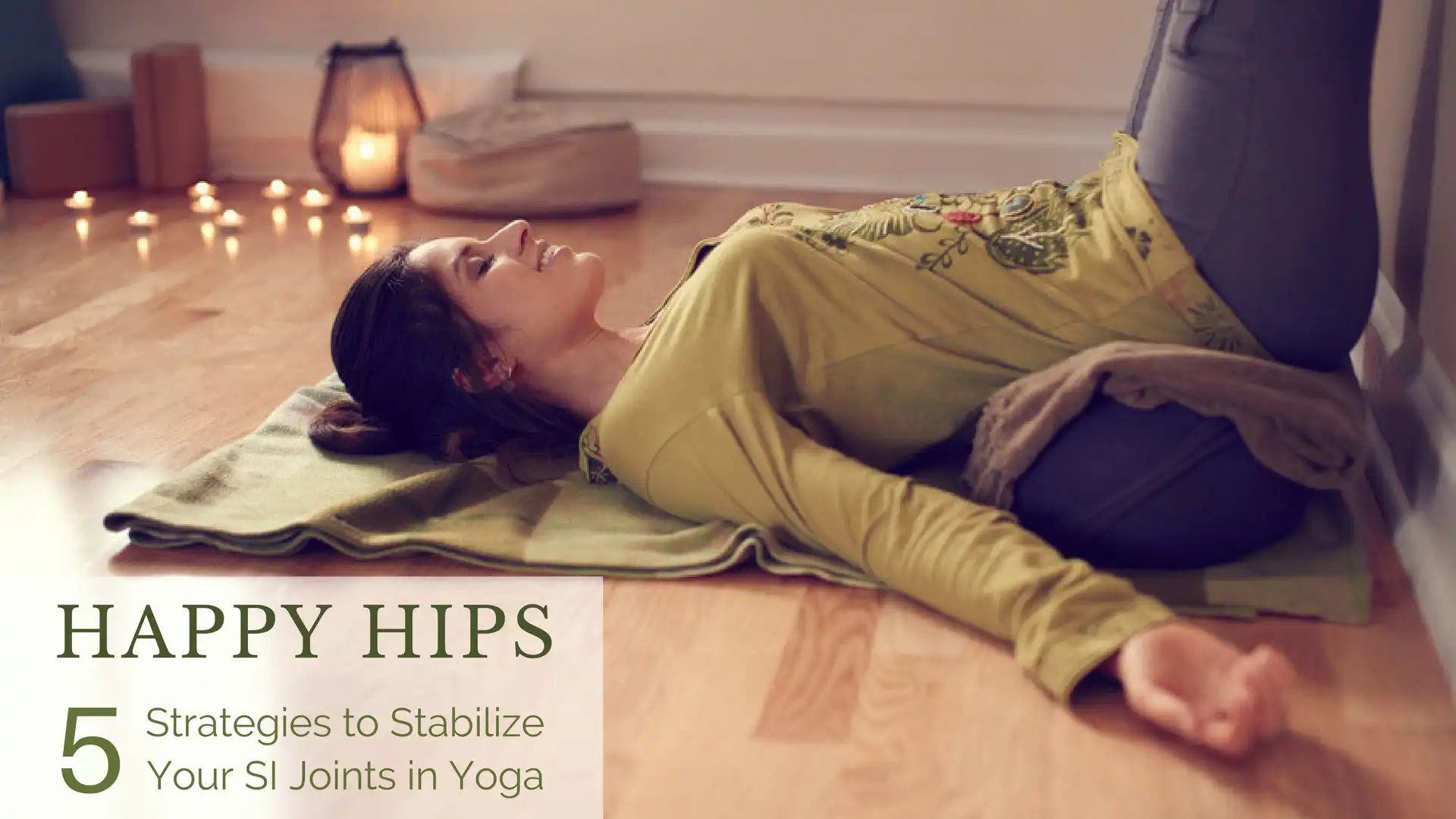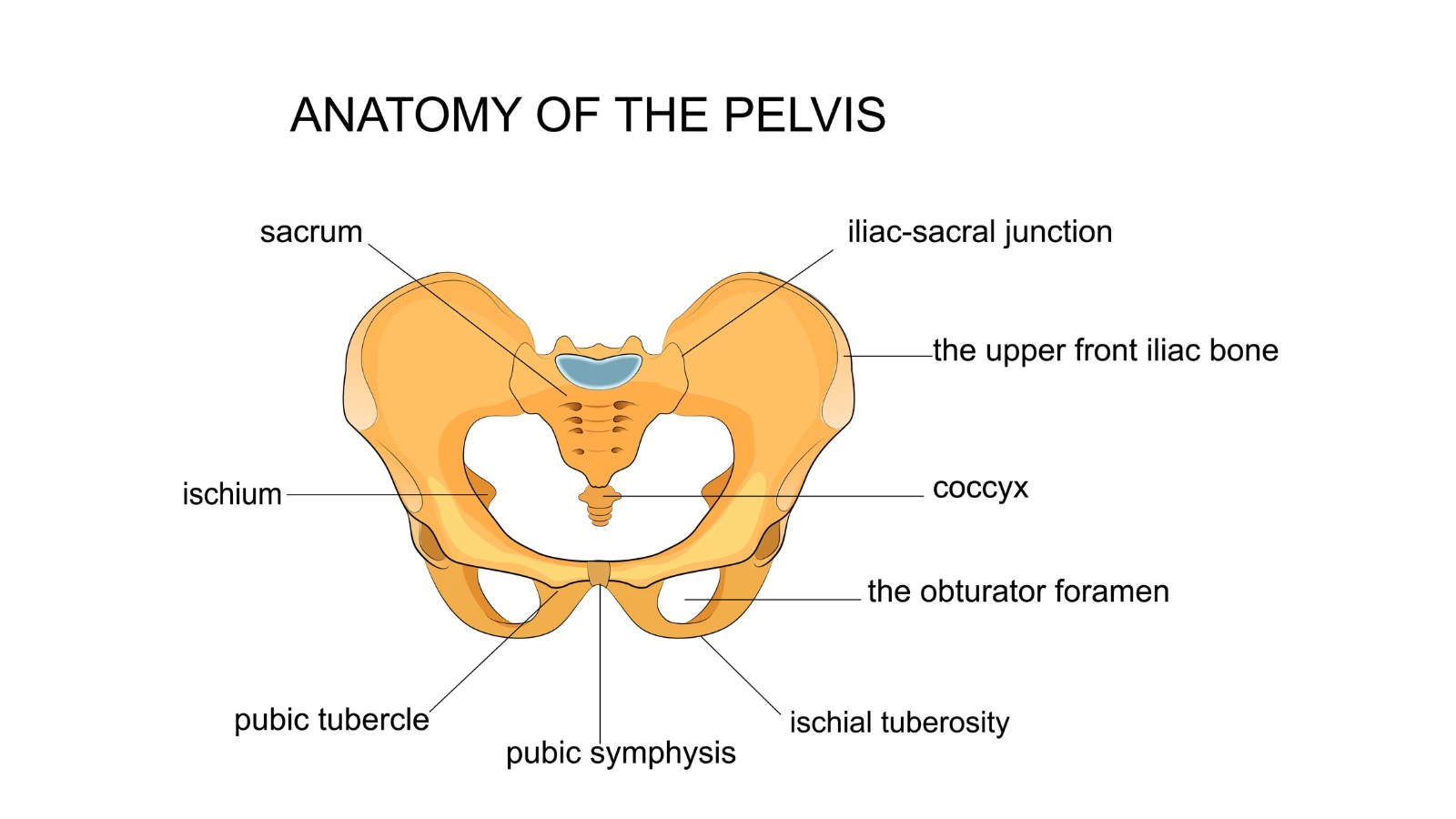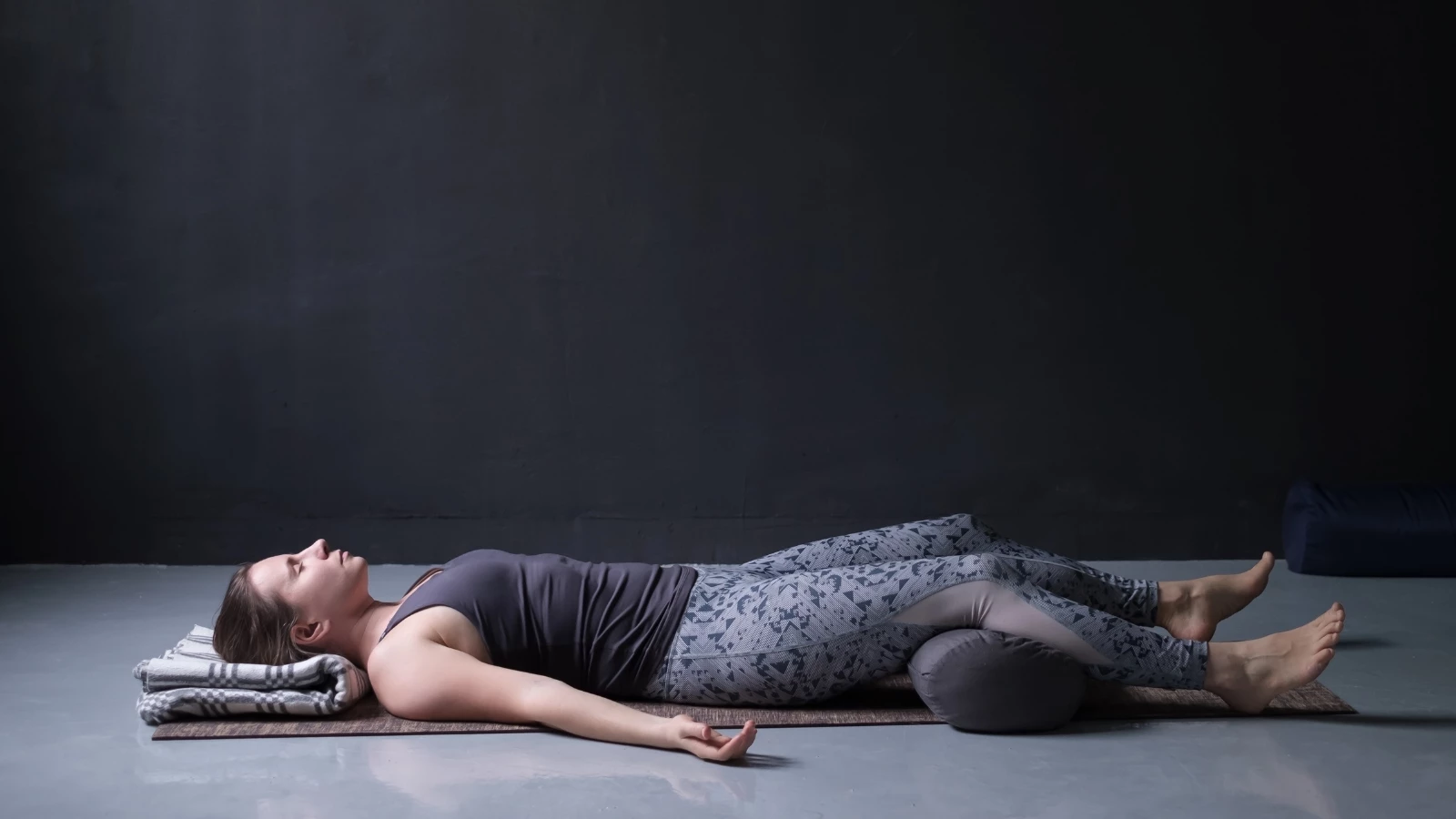Happy Hips: 5 Strategies to Stabilize Your SI Joints in Yoga

Article At A Glance
Hip-opening poses are ubiquitous in yoga practice. Unfortunately, hip replacements and sacroiliac joint (SI joint) problems are common among longtime practitioners. Practicing asanas that promote stability can balance our flexibility with strength and keep our hips and SI joints happy. Here are five ways to care for your SI joints.
In 2015 I got a brand-new left hip joint. The relief was immediate. In a matter of weeks, I progressed from being unable to walk more than three blocks to walking more than a mile—with no pain.
When my surgeon first looked at my X-rays before the replacement, he said, “It looks like you want to replace your right hip joint.” Huh? My right one, the one that wasn’t bothering me, actually looked worse in the pictures. So I knew that another replacement would be in the cards sometime soon.
Sure enough, the time came in December 2016. While there wasn’t a whole lot of pain or discomfort, I decided not to wait until it became unbearable, a mistake I made the first time around. What I didn’t realize is that even though I didn’t feel a whole lot of discomfort in my right hip joint, the dysfunction in the joint was causing all sorts of other problems.
Why Do Hip Joints Wear Out?
My diagnosis was hip dysplasia, a condition in which the hip sockets are either shallow or the wrong shape. When the hip sockets are shallow, as mine were, the femur head doesn’t seat properly in the joint. Instead, it moves around, wearing down the cartilage, both on the head of the femur and often the labrum, the fibrous rim of cartilage that lines the hip socket and forms a stabilizing lip around the femur head.
For decades, my sacroiliac joint (SI joint) was prone to subluxation, a misalignment of the bones. SI joint dysfunction can be caused by several types of misalignment. While I’m not sure of the exact nature of the problem in my case, it not only affected my yoga practice, but also my normal functioning. What began with a stabbing pain in the right side of the joint often progressed to searing sciatica. In the year leading up to my second hip replacement, these conditions were almost constant.
I’ve experienced only one minor SI joint episode since my second hip replacement. It lasted 24 hours and never progressed to sciatica. So why would a hip replacement improve my SI joint function so radically?
The Hip and SI Joints

The joints of the pelvic girdle include the pubic symphysis, the sacroiliac joints (right and left), and the hip joints (right and left). The pubic symphysis is designed to be immobile but can move a tiny bit during childbirth. The SI joint is a mostly stable joint with a slight amount of mobility to allow for efficient movement when we walk. The ball-and-socket hip joints are strong and stable but also quite mobile. Their design allows flexion, extension, adduction, abduction, and lateral and medial rotation.
The SI joints form the link between the spine and the pelvis. They are the hub for the transmission of force between the torso and the lower extremities. Formed by the sacrum, the solid, triangular-shaped bone at the base of the spine that consists of four or five fused vertebrae, and—on either side—the ilium, the posterior pelvic bones, the joints are held together by strong ligaments. Stability and strength in these joints are important because sixty percent of our body weight is transferred through them.
As movement in one joint affects movement in the others, what was happening to me was that the instability caused by my hip dysplasia also caused dysfunction of my SI joint. They’re inextricably connected.
The Problem with Hip Opening in Yoga

When we force our legs and hips into extreme “hip opening” poses—Ardha Yoga Nidrasana (Half Sleeping Yogi Pose or Foot Behind the Head Pose), Hanumanasana (Monkey Pose or Splits) or even the prep for Eka Pada Rajakapotasana (Pigeon Pose)—the neck of the femur can press against the edge of the hip socket. This not only wears down your cartilage and labrum, but the extreme leverage against your pelvic bones can cause an uneven force on the SI joint ligaments.
As the SI joints are not supposed to move much, when we continually displace them—even if it’s just a small amount—those stabilizing ligaments can become overstretched. Ligaments are composed of collagen and lack a good blood supply. Their main function is to limit the movement of a joint. When they become overstretched, they can’t do their job of protecting our joints. Once overstretched, they don’t return to their original length. Often our muscles have to tighten to take up the slack. This leads to an SI joint that’s prone to subluxation.
SI Joint Health: Stability vs. Mobility in Yoga
In my experience as a longtime asana teacher, SI joint dysfunction is the most common yoga-related injury. It’s most prevalent among women. In 30-plus years of teaching yoga asana, only two men in my classes have had SI joint problems. Both of these cases were caused by traumatic injuries, not by normal wear and tear. There are several reasons why women experience more SI joint dysfunction than men do:
- Women’s SI joints have two articulating points, whereas men’s SI joints have three.
- Women’s ligaments naturally become more lax at certain times during the menstrual cycle and in pregnancy.
- Women’s proportionally wider hips cause greater shearing action on the SI joints when we walk or run.
In yoga, we often think that stretching is the solution to our aches and pains, and sometimes it is. In the case of a dysfunctional SI joint, however, the joint is usually too mobile. Hypermobility can cause misalignment of the pelvic bones (including anterior or posterior rotation of the ilium, rotation of the sacrum inside the joint, and superior or inferior slipping of the ilium).
So what’s the solution? In a word, stabilizing. We spend a lot of time talking about and practicing hip opening in yoga asana practice. Of course, it’s important to keep our joints mobile. But there is such a thing as being too flexible, just as there is such a thing as being too tight. Neither is a condition of balance.
5 Strategies to Stabilize Your SI Joints in Your Yoga Practice

Whether your goal is to help yourself or a student alleviate SI joint pain or prevent it in the future, here are a few guidelines:
- Start your yoga practice with stabilizing asanas, especially if you plan to practice hip-opening poses as well. These include one-legged balancing poses, Utkatasana (Fierce Pose), and standing poses such as Virabhadrasana I and II (Warrior I and II). These yoga poses are all fine to do if you are not experiencing SI joint pain.
- If you or your student is experiencing SI joint pain, practice poses that allow your legs to be in a symmetrical position. Avoid twisting until your SI joint stops hurting. Helpful poses include Utkatasana (Fierce Pose), Adho Mukha Svanasana (Downward Facing Dog Pose), Salabhasana (Locust Pose and its variations), Prasarita Padottanasana (Wide-Legged Forward Bend Pose), Upavista Konasana (Seated Angle Pose), and Viparita Karani (Legs Up the Wall Pose). If your SI joints are already complaining, asymmetrical poses, such as lunges, and standing poses, like Warrior and Trikonasana (Triangle Pose), can potentially exacerbate the problem. If the above poses feel okay and don’t cause pain, you can try Uttanasana (Standing Forward Bend) and Paschimottanasana (Seated Forward Bend). I tend to avoid these poses in the throes of SI joint discomfort because they can overstretch the soft tissue around the joints.
- Prone backbends are excellent for stabilizing the soft tissue around your SI joints. Try Salabhasana (Locust Pose), Bhujangasana (Cobra Pose), and Setu Bandha Sarvangasana (Bridge Pose). That said, Urdva Mukha Svanasana (Upward Facing Dog Pose) may be too intense if your SI joint is in pain.
- Practice Viparita Karani (Legs Up the Wall Pose). When the weight of the legs feeds down into your hips in this pose, it can help bring the joint back into a neutral position. I like practicing the version that utilizes a bolster under the pelvis. This post explains how to set up Viparita Karani.
- Don’t forget Savasana. When you have SI joint discomfort, it’s especially helpful to elevate your legs. You can rest your lower legs on the seat of a chair, or you can rest the backs of your knees on a rolled-up blanket or bolster.

 Charlotte Bell began practicing yoga in 1982 and began teaching in 1986. She was certified by B.K.S. Iyengar in 1989 following a trip to Pune. In 1986, she began practicing Insight Meditation with her mentors Pujari and Abhilasha Keays. Her asana classes blend mindfulness with physical movement. Charlotte writes a column for Catalyst Magazine and serves as editor for Yoga U Online. She is the author of two books: Mindful Yoga, Mindful Life and Yoga for Meditators, both published by Rodmell Press. She also edits Hugger Mugger Yoga Products¹ blog and is a founding board member for GreenTREE Yoga, a non-profit that brings yoga to underserved populations. A lifelong musician, she plays oboe and English horn in the Salt Lake Symphony and the folk sextet Red Rock Rondo whose 2010 PBS music special won two Emmys.
Charlotte Bell began practicing yoga in 1982 and began teaching in 1986. She was certified by B.K.S. Iyengar in 1989 following a trip to Pune. In 1986, she began practicing Insight Meditation with her mentors Pujari and Abhilasha Keays. Her asana classes blend mindfulness with physical movement. Charlotte writes a column for Catalyst Magazine and serves as editor for Yoga U Online. She is the author of two books: Mindful Yoga, Mindful Life and Yoga for Meditators, both published by Rodmell Press. She also edits Hugger Mugger Yoga Products¹ blog and is a founding board member for GreenTREE Yoga, a non-profit that brings yoga to underserved populations. A lifelong musician, she plays oboe and English horn in the Salt Lake Symphony and the folk sextet Red Rock Rondo whose 2010 PBS music special won two Emmys.



